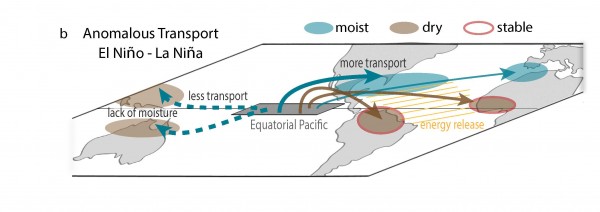The role of atmospheric transport in El Niño
The El Niño Southern Oscillation (ENSO) is one of the most important modes of climate variability worldwide, with large impacts on the weather conditions in many regions, and thus on agriculture and economy. It is related to changes in the sea surface temperatures in the Tropical Pacific Ocean. Periods with higher temperatures cause the so-called El Niño phenomenon. This phenomenon causes pronounced weather anomalies in many regions around the world, for example, droughts in the Amazon basin. These far-ranging impacts are called teleconnections.
The role of air mass transport
Despite a lot of research that has been done on ENSO, the mechanisms behind the observed teleconnections are still not well understood. Researchers at the University of Vienna now made a breakthrough 1 in our understanding of the role of air mass transport in these teleconnections. They found that variations in the transport of air mass, heat, moisture and energy from the Tropical Pacific are causally responsible for many of the observed climate anomalies.

Katharina Baier, first author of the study, explains: “The main benefit of our study is the different perspective on teleconnections, as we look at how the heat and moisture from the Pacific Ocean is transported via the atmosphere. We can thus establish a direct connection between the Pacific and remote regions. For instance, we can show that anomalously dry air is transported towards the Amazon Basin during El Niño, causing droughts there. In contrast, anomalously moist air is transported toward the southeastern U.S., which favours increased precipitation.”
El Niño is also warming the Atlantic Ocean
Andreas Stohl, who has led the study, points out: “Our results contribute to the understanding of weather phenomena worldwide, for instance also in Australia, Africa, or the Mediterranean. In addition, we can show that anomalously large amounts of heat are transported from the Tropical Pacific towards the Atlantic Ocean during El Niño, which then responds by warming.”
Methodologically, the research team at the University of Vienna relied on atmospheric dispersion models, the so-called Lagrangian models. While conventional models record meteorological parameters such as humidity or temperature at certain positions, Lagrangian models follow the individual particles and capture how the meteorological parameters change along their way. These models can also be used to analyse the dispersion of particles such as soot, microplastics, or greenhouse gases.
References
- , , , , , & (2022). The role of atmospheric transport for El Niño-Southern Oscillation teleconnections. Geophysical Research Letters doi: 10.1029/2022GL100906 ↩